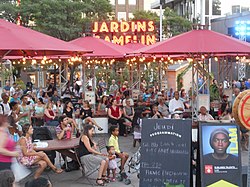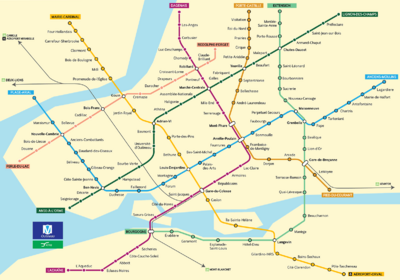Outineau
Place de la Confédération Musée pour la planète Pont Louis-Desjardins rue Anchois in Ville-Baptiste district | |
| Republic Country |
Beaulac |
| Population City Metro area |
7,289,441 14,455,944 (2nd) |
| Time zone | Kelssek Coastal Time |
Outineau is the provincial capital and most populous city of Beaulac. An important global city, Outineau has a diverse and multicultural population with Frankish being the most widely-spoken language in the city. It is renowned for its vibrant cultural scene and hosts a wide variety of major international sports and cultural events. As of the 141FE census, Outineau has a population of over 7 million people and its metropolitan area (known as Région Ôshaga or the Oshaga region) had 14.1 million inhabitants making it the second-most populous urban area in Kelssek.
A major economic centre, the main employers in the city are the sectors of financial services, education, the provincial government, aerospace, and media. Tourism and entertainment are important economic sectors; the city is Kelssek's most-visited foreign tourist destination. Outineau is also a major hub for the aerospace and transportation technology industry; it is the location of the head office and several major production facilities of Celestar, which is the largest manufacturing firm in Kelssek. With eight universities in the city and metropolitan area, Outineau is an international centre for higher education, research and innovation with Kelssek's largest concentration of post-secondary students.
In the commercial sector, the city is the headquarters of the Société des Caisses, the credit union network which is the province's largest financial institution, and is Kelssek's second-largest centre for commercial banking after Kirkenes in addition to being the location of Kelssek's national commodities and securities exchanges. Pharmaceuticals, media, film and television production, oil refining, and foods are the city's other important industries. Software, video game, and visual effects production are also important sectors, with large tech campuses in the outlying cities of Longevin and Saint-André, but some larger companies like UxTor and Studios JeuxJoo having located themselves downtown as well.
Outineau was the host city of the 5th Summer Olympics and the final of World Cup 46.
History
| Statue of Chartris at Place d'Armes. |
Outineau is thought to have been first settled in the late 14th century. During the Guedian Kingdom it was the home of the Lord of Paulanice (who was colloquially referred to as the Prince of Beaulac, although the name Beaulac was not formally used at the time) and the capital of the principality. During this period, fur trapping, maple syrup, and timber from the forests surrounding the city became its major industries and source of wealth. The city grew into a transportation and economic hub from its strategic location controlling access between Lake Claire and water access to the interior's farmland.
Outineau was the home of the folk hero Louis Chartris des Pins. Chartris was a rouge knight who turned against the Prince Regent James VII, who he felt was mistreating the peasants. James VII had also declared the rightful Prince insane and imprisoned him in his chambers. Chartris led a failed rebellion to free the Prince and was captured and hanged by the Prince Regent's forces in 1696. Stories about Chartris, which play on his heroism and swordsmanship, are an important historical part of Kelssek culture, perhaps best shown in the book L'épée de Chartris (The Sword of Chartris) which is thought to have originated in the late 1700s.
Outineau was a hub of revolutionary activity in the late 19th century as momentum to overthrow the monarchy grew. Louis Desjardins was among several influential leaders who helped to grow the movement in Outineau and in Beaulac. The Movement for a Socialist Republic, one of the critical groups in the revolution, was founded in Outineau and army regiments in the city were among the first to turn to the cause of the Revolution.
Following the 1889 revolution and overthrow of the monarchy, Outineau became a major commercial and financial centre. Outineau's population reached the one million mark in 1910, helped by a huge influx of immigration. While the cheap labour source proved an economic boon, the period was also marked by deteriorating sanitary conditions and widening social inequality. Housing and education spending as well as infrastructure upgrades brought by the government of Kieran Pearson helped relieve these problems and Outineau began to grow into a city more recognisable to the people of today.
City life

|
The city's dynamic cultural scene is part of daily life in Outineau. The Quartier Rouge, especially, is a neighborhood crowded of cafés animated by literary and musical activity. Outineau is also a haven for the classical arts; which centre around the Palais des Arts. The Palace is a sprawling arts complex with several halls for musical, dance, and theatrical performance of all kinds and is home to Les grands ballets Kelssekiens, Opéra d'Outineau, and the Orchestre symphonique d'Outineau. The base of the world-renowned circus troupe Cirque de Lune is located at Vieux-Port. Among the most-visited neighbourhoods is the district of La Petite-Ariddie (Little Ariddia), which is the historical centre of the Ariddian diaspora in Kelssek and where all the best vegetarian restaurants are.
Outineau has long been known for its well-established restaurant scene and is hailed as a premier foodie destination with an array of famed chefs and restaurants. Some of these chefs can be found in the mornings examining the produce at the Marché du Nord or the Marché du Havre, the latter being the offload point for fishing trawlers coming in from the coast. A wide range of cuisines are represented in the multicultural city. Its most well-known local foods, however, are rather humble one - smoked brisket (known as viande fumée d'Outineau or simply viande fumée), and "poule mouillée", chicken barbecued with a heady mix of spices and hot sauce.
Attractions and tourism
The city of Outineau is the most-visited tourist destination in Kelssek. The city's nightlife and joie de vivre are often cited as its main attractions, and perhaps is the strongest downtown and in the Plateau-Mont-Phare district, but more specific sights include Ville-Baptiste, the city's historic district and location of well-known landmarks such as the Marché Bounsecasseil, Place d'Armes and the statue of Louis Chartris, the Basilique Notre-Dame, Champ d'Avril, and Palais National, the historic building which formerly housed the republic's legislature.
The Museum for the Planet, an iconic spherical structure housing a museum of hydrological ecosystems, is located on the Île Saint-Hélène, which is also the site of several music festivals every summer. The Musée nationale d'aviation (National Museum of Flight) is also a popular attraction located on the outskirts of the city which is a major draw for visitors with families. Artistic institutions include the Musée des Beaux-Arts and the Musée d'art contemporain d'Outineau, two of Kelssek's largest art museums, while others may also prefer to see the famously avant-garde exhibits of the Musée d'art moderne. Another city landmark is the Hôtel du Parlement, an abstract-modernist style building completed in 1994 which houses the Assemblée nationale du Beaulac, located in the Bellechasse district on the grounds of the Parc de l'Assemblée, which contains many statues, busts, and other monuments to prominent citizens of Beaulac.
Media
As the cultural and political hub of francophone Kelssek, Outineau is also a centre of Frankish-language media production, with substantial television, radio, theater, film, multimedia and print publishing taking place in Outineau. The digital news outlet Cult began its life as a counterculture magazine in the city's punk scene. Outineau's main daily newspaper, L'Étoile , produces Anglian and Frankish editions and has the widest circulation in Kelssek when both editions are combined. It competes with the Anglian-language Outineau Press, the right-leaning Frankish newspaper La Gazette and Le Courrier Kelssekien, a national Frankish-language newspaper, which is also produced in Outineau.
In television and radio broadcasting, Société Radio-Kelssek, the Frankish-language arm of the Kelssek Broadcasting Corporation, is also headquartered at the Maison Radio-Kelssek in Outineau, which houses its production facilities and offices. Outineau is also the headquarters of TéléBeaulac, the public broadcaster funded by the Beaulac government, and the private Frankish-language networks Reseau-Nationale and TV4.
Transportation

|
| Map of Outineau's metro system |
Outineau has a highly developed public transportation system, using a network of subway trains, known as the Métro, commuter rail, and buses administered by the Société de transport d'Outineau (STO), an agency of the city government. Over 2 million commuters use the system every day. Gare Centrale is the city's main passenger railway station and is served by the Velocit high speed rail system as well as intercity Kelssek Pacific services.
The city is served by two airports. The primary airport is Mirabelle Airport located 41km north of the city, a major international hub connected to downtown and the Metro system by an express train to Gare Côte-Couche-Soleil. Orvelle Airport is a secondary airport which serves domestic and some regional flights, and has its own Metro stop. Both are hubs for Air Kelssek's route network. In total, the two airports served 70.6 million passengers in 2018, with 63.1 million at Mirabelle and 7.5 million at Orvelle.
Outineau is also the focal point for the provincial Autoroute highway system, and the Federal Highway 1 runs through the northern part of the city, around Lake Claire and south to Haligonia. Vistors to the grounds of the National Assembly may notice a bronze circle in square outside the buildings which marks "point zéro" from which distances on the province's highway system are measured.
Sports
| File:Stadeoutineau.jpg |
| With a capacity of over 80,000 Stade Outineau is the largest stadium in Kelssek. |
Hockey is by far the most popular sport in Outineau and CH Outineau, with more Desjardins Cup championships than any other KHL team, is as much a sports team as a symbol of the city itself. However, the Rugby Superleague's Nordiques are also very popular and have maintained an impressive record of selling out every home match since 2003.
Circuit Jacques-Strappe, located on an artificial island in the delta just southeast of downtown Outineau, hosted the Grand Prix du Kelssek of the World Grand Prix Championship, which is Kelssek's largest motorsport event, and is the headquarters and main test track of the Revél-Celestar WGPC team. The circuit also hosts races in Kelssek's domestic motorcycle grand prix circuit.
Outineau hosted the 5th Summer Olympics, with the Stade Olympique d'Outineau serving as the Olympic stadium and centrepiece for the event. The final of the 46th World Cup was held at Stade Outineau; in a memorable final Dancougar beat Daehanjeiguk 5-4 in front of a full stadium of over 81,000 spectators. The stadium was built for the World Cup and afterwards became the home ground of the Nordiques rugby team. The stadium was also the venue for the 44th UICA Champions’ Cup final, won 4-2 by FC Axel Heiburg over Yuba United.
Professional sports teams
| Team name | Sport | League | Home venue |
|---|---|---|---|
| CH Outineau | Ice hockey | Kelssek Hockey League | Aréna St-Jacques |
| Escadron de Dorval | Ice hockey | Kelssek Hockey League | Place Henri-Bouchard |
| Nordiques Rugby | Rugby union | Rugby Superleague | Stade Outineau |
| Kraken d'Outineau | Water polo | Water Polo Premier League | Centre Saint-Hélène |
| Daudard-des-Oiseaux | Water polo | Water Polo Premier League | Complexe sportif DDO |
| Association Ariddienne | Football | Kelssek National | Stade Pailler[1] |
| CF Les Castors | Football | Kelssek Championship | Place Saint-Luc |
| CF Outineau | Football | Kelssek Championship | Stade Olympique |
- 1. As the stadium does not meet Kelssek Championship standards, they used the Pavillion d'éducation physique et des sports de l'Université d'Outineau for home matches during the period they were in the first division.



